Research Directors from the National Observatory of Athens describe how their Earth observation expertise poises them to contribute meaningfully to the pioneering e-shape project.
The H2020 project e-shape (EuroGEO Showcases: Applications Powered by Europe) is at the forefront of Europe’s interaction with the Group on Earth Observations (GEO); through establishing ‘EuroGEO’, Europe’s contribution to the Global Earth Observation System of Systems within GEO. This Regional Initiative aims at bringing together Earth observation (EO) resources in Europe, such as satellites, land monitoring stations as well as smart sensors; and it allows Europe to position itself as a global force in EO through leveraging the Copernicus Programme, making use of existing European capacities and improving user uptake of the data from GEO assets.
Moving away from a data-centric approach to a user-driven era
e-shape is a unique project which brings together decades of public investment in Earth observation and cloud capabilities into services for decision makers, citizens, industry and researchers. It entails 27 cloud-based pilot applications under seven thematic areas which address societal challenges, foster entrepreneurship and support sustainable development, in alignment with the three engagement priorities of GEO (UN 2030 Agenda for Sustainable Development, Paris Agreement on Climate Change, and Sendai Framework for Disaster Risk Reduction).
The project will co-ordinate EO actions and leverage existing European heritage, benefiting from open science, innovation and linking to GEO flagships and initiatives; and setting sustainability of the tools as a strategic target. Rigorous and continuous co-design is a distinctive feature of e-shape to deliver concrete EO-derived benefits with and for users, all while implementing a co-ordinated and comprehensive portfolio of activities emphasising user uptake, operational services, business support and a proactive outreach strategy. Throughout the duration of the project, e-shape will onboard new pilots – currently being externally developed – in an inclusive manner, and provide them with access to strategic insights, resources and communication channels.
Why does e-shape matter?
e-shape is a game-changer in exploiting EO to deliver robust environmental information, advocate and enable informed decision making as it:
- Fosters the development of valuable Earth observation services with and for the users;
- Supports the co-ordinated exploitation of EO data and services across the whole ecosystem of actors in Europe and beyond;
- Co-ordinates the European contribution to GEO, making the most of European investments in Copernicus and multiple major research and development projects;
- Generates key tools that will benefit the sustainability of EO activities now and in the future, through open and inclusive processes;
- Streamlines the access to key resources (knowledge, technology, markets and capital) allowing researchers, developers and industrial actors to deliver services that bring concrete benefits to a number of key societal sectors; and
- Breaks through barriers, helping to scale up services and building a critical mass of users across borders and sectors.
The role of the National Observatory of Athens in e-shape
The National Observatory of Athens (NOA), as the first research institution created in Greece in 1842, performs research ranging from astronomy and astrophysics to remote sensing and environmental science and climatology. NOA has become a very active player in the EO arena during the last few decades, contributing substantially to both the research and the governance efforts of the EO community, via GEO, and the European Commission-led EuroGEO. NOA as a whole maintains several EO assets, which enable NOA to hold a strong role within the e-shape project specifically through two bodies: the Atmospheric Physics and Chemistry Group (APCG) and the BEYOND Centre of Excellence.
APCG, a group within the Institute for Environmental Research and Sustainable Development (IERSD) at NOA, leads the Health Surveillance Air Quality Pilot further described below, employing novel EO technologies to enrich decision maker, citizen, and stakeholder knowledge of health risks related to air pollution in the urban setting. The BEYOND Centre of Excellence, hosted by the Institute for Astronomy, Astrophysics, Space Applications and Remote Sensing (IAASARS) of NOA, serves as the co-ordinator for the Disasters showcase within e-shape; and also leads two pilots, one focusing on resilient food/agriculture (ReSAgri) and the other on solar energy forecasting (nextSENSE).
The Health Surveillance Air Quality (HSAQ) pilot
Within the Health Surveillance Showcase of e-shape, NOA/APCG leads Pilot 3 on ‘Health Surveillance Air Quality’, which uses EO to profile the health risks posed by pollution in the urban environment. As the ever rising growth of urban populations will continue, the majority of which is exposed to levels of air pollution exceeding recommended and legal guidelines, it is deemed critical to provide open, robust and digestible information linking air quality (AQ) and health risks to guide policy implementation and increase citizen awareness.
The HSAQ pilot aims to enhance urban resilience with respect to AQ and its relevance to health and urban planning by creating a service combining existing EO infrastructure, which address global, city and municipality scales. The service further bridges past (trends), present (analysis) and future (AQ scenarios) and ultimately, as a platform driven by co-design, it will provide a reference space for users and stakeholders offering thorough insight into urban AQ.
Exploiting the synergy between EO platforms to capture urban AQ complexities while also addressing data quality issues such as citizen science and low cost sensors; the concept is to provide a modular service consisting of an overarching global/horizontal layer, along with specific/vertical city cases that utilise local data, giving a comprehensive view of city AQ and health exposure, catering to unique city needs.
The global component, led by pilot partner the German Aerospace Center (DLR), employs existing satellite-driven platforms that contain AQ, socioeconomic and population information for thousands of cities worldwide. Building on this, DLR is also testing the feasibility of supporting city-level AQ information in Munich, Germany via satellite. Honing in on industrial emissions in Finnish cities (Helsinki, Porvoo and Turku), FMI (Finnish Meteorological Institute) provides the relevant, satellite derived emissions data. IIASA (International Institute for Applied Systems Analysis) combines citizen science and AQ in Vienna, Austria. Lastly, NOA is integrating city-scale AQ modelling and dynamic population exposure with health and socioeconomic data at the municipality level in Athens, Greece.
Eventually, the co-design between partners, which also include the National Research Council of Italy (CNR) and Draxis Environmental SA, and stakeholders will lead to a more efficient HSAQ service including novel and unique health-risk indicators.
The Resilient and Sustainable Ecosystems Including Agriculture and Food pilot
The “Resilient & Sustainable ecosystems including Agriculture & food” pilot (ReSAgri) is led by NOA/BEYOND with the participation of Neuropublic, a SME partner. This pilot falls within the Disasters Resilience Showcase, which is also co-ordinated by NOA/BEYOND; and which is of high importance given that natural hazards such as droughts, floods, heatwaves and high winds play a dominant role in natural ecosystems and agriculture, and by extension, food, resiliency and sustainability.
The large insurance company INTERAMERICAN SA, as well as the GAIA EPICHEIREIN association of farmers are the two co-designers for this Pilot.
ReSAgri is composed of three main pillars:
- Gathering and processing of raw EO data, leveraging DIAS cloud services and integrating multiple other data sources (in situ, modelled);
- Risk disaster modelling (multi-risk assessment), high resolution (2km) numerical weather prediction, delivery of timely and accurate information such as alerts to relevant stakeholders including farmers, agriculture co-operatives and insurance companies; and
- Crop type and natural ecosystems mapping, leveraging EO research capacities that rely on agriculture related machine learning methods, integration with meteorological information and disaster assessments and forecasts, building robust thematic information for user communities.
Exploration of the links between droughts, floods, heatwaves, and high winds with risk, in synergy with the EU-CAP Support Pilot (also led by NOA/BEYOND) of the Food Security and Sustainable Agriculture showcase.
The ReSAgri Pilot thus generates beyond the state-of-the-art downstream products and contributes to Copernicus user uptake by engaging the agriculture production and insurance sector. ReSAgri works towards the overall ecosystem resilience and food security processes; and brings economic value both by contributing to optimal food production and by attracting or supporting new businesses.
The e-shape project has received funding from the European Union’s Horizon 2020 research and innovation programme under grant agreement 820852.
Dr Evangelos Gerasopoulos
Research Director, Head of APCG,
HSAQ Pilot Co-ordinator
Dr Haris Kontoes
Research Director, Head of BEYOND, ReSAgri Pilot Co-ordinator
National Observatory of Athens (NOA)
+30 210 8109124
+30 210 8109186
egera@noa.gr
kontoes@noa.gr
Please note, this article will also appear in the third edition of our new quarterly publication.










